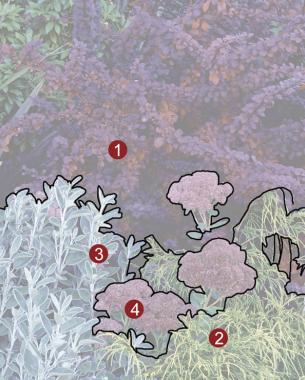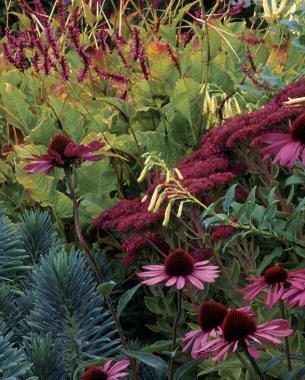
I love the sun and all the bright, glorious colors of summer in my garden. So when the cool evenings begin in the Pacific Northwest, I get a certain sinking feeling. I know that the rain is not far away and that it won’t be long before I am doomed to look out my window at a dark and dripping garden.
But I’m not one to give up easily. Autumn does not need to be a season where a garden gradually loses interest as plants slip into dormancy. Rather than treating fall color as an afterthought or a happy accident, I intentionally design combinations and vignettes that will have my garden bursting with interest well past our first frost. Though these combinations peak in the fall, they are anything but dull during other seasons. And the best part about them is that the principles that guide the designs are adaptable to all climates and conditions.
Use dramatic forms where you seek attention

Plants with a striking, architectural form work wonderfully in areas that get a lot of attention, such as near a front door. ‘Rainbow Warrior’ New Zealand flax is a plant certain to make people notice. Since this spiky plant draws the eye up, the combination needed something that would elegantly hold the combination to the ground. I chose a perfect color match in ‘Apricot’ chrysanthemum, whose little explosions spread the attention in all directions. The soft gray of the silverbush calms the combination down and keeps it from being too busy. The silverbush and the euonymus also ensure interest in other seasons. The perfect backdrop to this scene is the delicate, ever-changing fall foliage of a laceleaf Japanese maple.
1. ‘Rainbow Warrior’ New Zealand flax (Phormium ‘Rainbow Warrior’, USDA Hardiness Zones 8–10)
2. ‘Apricot’ chrysanthemum (Chrysanthemum ‘Apricot’, Z 5–9)
3. Euonymus (Euonymus fortunei ‘Emerald ’n Gold’, Z 5–9)
4. Silverbush (Convolvulus cneorum, Z 8–11)
5. Laceleaf Japanese maple (Acer palmatum var. dissectum, Z 6–8)
Take advantage of fading foliage


Fall color is often the result of leaves turning before they drop, a benefit all enjoy but few use to their benefit. The always-attractive ‘Madame Emile Mouillère’ hydrangea adds a glorious touch of rosy red to its leaves in autumn. Rather than marvel in this beauty by itself, I enhance the seasonal gift with plants that complement the color and shape of the hydrangea. This shrub and the sedum below it offer flower heads that form a large mass. The crimson tinges in the hydrangea flower only strengthen the connection between the plants. A Japanese forest grass planted at the feet of the elegant hydrangea will echo the color and shape of the soft yellow veins in the shrub’s foliage. As the colors of these plants continue to change and fade in late fall, the whole combination takes on new dimensions.
1. ‘Madame Emile Mouillère’ hydrangea (Hydrangea macrophylla ‘Madame Emile Mouillère’, Z 6–9)
2. ‘Autumn Joy’ sedum (Sedum ‘Autumn Joy’, Z 3–11)
Let softer hues connect strong colors


Fall is a season when colors can grow more intense. This characteristic is most often an asset, but occasionally it can become a liability. Throughout most of the year, the yellow-edged border of ‘Golden Ring’ Japanese barberry connects its strong burgundy foliage to the equally strong-colored ‘Golden Mop’ false cypress, resulting in a perfect pair. But in autumn, the barberry’s gold band fades away, leaving the two plants disconnected instead of matched. To fix this situation—and create a great combination—I added the silver foliage of ‘Sunshine’ senecio, which helps tone down the strong colors all year long. In fall, the sedum’s soft red flowers also help the situation while complementing the dark shrub behind it.
1. ‘Golden Ring’ Japanese barberry (Berberis thunbergii ‘Golden Ring’, Z 5–8)
2. ‘Golden Mop’ false cypress (Chamaecyparis pisifera ‘Golden Mop’, Z 4–8)
3. ‘Sunshine’ senecio (Senecio greyi ‘Sunshine’, syn. Brachyglottis Dunedin Hybrids ‘Sunshine’, Z 9–10)
4. ‘Autumn Joy’ sedum (Sedum ‘Autumn Joy’, Z 3–11)
Blend textures to add excitement


Blends of texture create excitement in any season. The skinny blooms of ‘Firetail’ persicaria have the softest texture in this group, but their mass and movement create enough interest to hold their own against the drama queen of the combination: Ruby Star purple coneflower. The big red flowers of trusty ‘Autumn Joy’ sedum connect the color of the bold coneflower to the wispy persicaria. The lemon yellow blooms of ‘Moonraker’ Cape fuchsia add a spark that sets off the combination’s color palette. The final touch is a euphorbia, whose soft tones and fine texture hold everything together.
1. ‘Firetail’ persicaria (Persicaria amplexicaulis ‘Firetail’, Z 3–8)
2. Ruby Star purple coneflower (Echinacea purpurea ‘Rubinstern’, Z 3–9)
3. ‘Autumn Joy’ sedum (Sedum ‘Autumn Joy’, Z 3–11)
4. ‘Moonraker’ Cape fuchsia (Phygelius × rectus ‘Moonraker’, Z 8-9)
5. Euphorbia (Euphorbia characias subsp. wulfenii, Z 7–10)
Create an impact with masses of fine texture


Soft textures and subtle colors provide a necessary transition between bolder colors in the border, but there is no reason why they can’t be eye-catching too. Repeating these textures and colors or planting them in masses is a wonderful way to create harmony and flow in a garden. Single plantings often look like polka dots, resulting in a busy composition that loses a sense of harmony in the border.
In this combination, a large swath of blue oat grass attracts the eye with its grace and movement. Its smooth blades contrast in texture but match the shape of the intricate spikes of ‘Corbett’s Red’ heather and ‘Pagei’ hebe, both planted in masses. A large clump of starburst-shaped New York asters stands out against the upward thrust of the other plants.
1. Blue oat grass (Helictotrichon sempervirens, Z 4–9)
2. ‘Corbett’s Red’ heather (Calluna vulgaris ‘Corbett’s Red’, Z 5–7)
3. ‘Hopleys’ oregano (Origanum laevigatum ‘Hopleys’, Z 7–10)
4. New York aster (Aster novi-belgii ‘Professor Anton Kippenberg’, Z 4–8)
5. ‘Pagei’ hebe (Hebe pinguifolia ‘Pagei’, Z 8–10)
6. Euphorbia (Euphorbia characias ssp. wulfenii, Z 7–10)
7. Artemisia (Artemisia stelleriana ‘Silver Brocade’, Z 3–7)
8. ‘Vera Jamson’ sedum (Sedum ‘Vera Jamson’, Z 4–9)
Make use of plants that always look good


One of my favorite plants, regardless of the season, is Japanese sedge. Its soft yellow and green blades provide mounds of movement and spots of light throughout my garden.
In fall, I play off this grasslike perennial’s attributes by adding the bright but soft-shaded blooms of ‘Oregon Sunset’ crimson flag and ‘Mönch’ aster. This combination reminds me of the grand finale of a fireworks display with rockets (the sedge) leaving bright, thin trails behind colorful bursts. If the gardening season has to end (or at least slow down), it might as well do it with a bang.
1. Japanese sedge (Carex morrowii cv., Z 5–9)
2. ‘Mönch’ aster (Aster × frikartii ‘Mönch’, Z 5–8)
3. ‘Oregon Sunset’ crimson flag (Schizostylis coccinea ‘Oregon Sunset’, Z 7–9)
Fine Gardening Recommended Products

The Nature of Oaks: The Rich Ecology of Our Most Essential Native Trees
Fine Gardening receives a commission for items purchased through links on this site, including Amazon Associates and other affiliate advertising programs.

Planting in a Post-Wild World: Designing Plant Communities for Resilient Landscapes
Fine Gardening receives a commission for items purchased through links on this site, including Amazon Associates and other affiliate advertising programs.

ARS Telescoping Long Reach Pruner
Fine Gardening receives a commission for items purchased through links on this site, including Amazon Associates and other affiliate advertising programs.

















Comments
Good post. Keep it up!
Log in or create an account to post a comment.
Sign up Log in